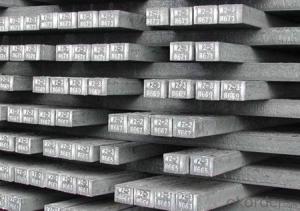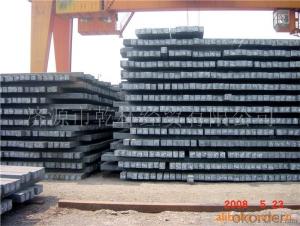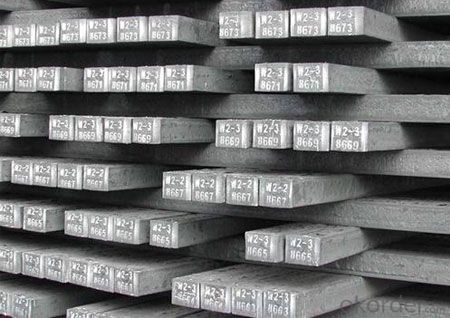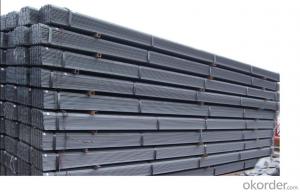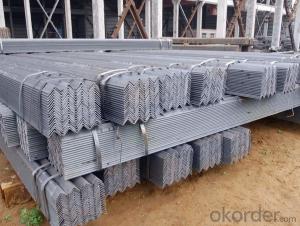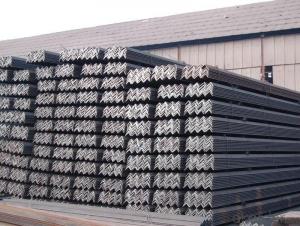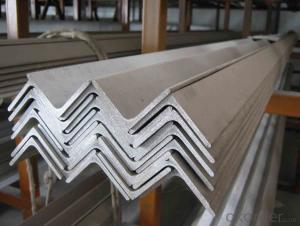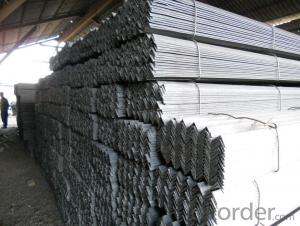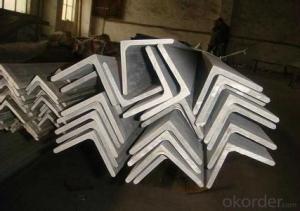Steel Equal Angle 20MM-250MM GB Q235 20-250MM
- Loading Port:
- Tianjin
- Payment Terms:
- TT or LC
- Min Order Qty:
- 25 m.t.
- Supply Capability:
- 200000 m.t./month
OKorder Service Pledge
OKorder Financial Service
You Might Also Like
Product Description:
OKorder is offering high quality Hot Rolled Steel I-Beams at great prices with worldwide shipping. Our supplier is a world-class manufacturer of steel, with our products utilized the world over. OKorder annually supplies products to European, North American and Asian markets. We provide quotations within 24 hours of receiving an inquiry and guarantee competitive prices.
Product Applications:
According to the needs of different structures, Angle can compose to different force support component, and also can be the connections between components. It is widely used in various building structures and engineering structures such as roof beams, bridges, transmission towers, hoisting machinery and transport machinery, ships, industrial furnaces, reaction tower, container frame and warehouse etc
Product Advantages:
OKorder's Steel I-Beams are durable, strong, and resist corrosion.
Main Product Features:
· Premium quality
· Prompt delivery & seaworthy packing (30 days after receiving deposit)
· Corrosion resistance
· Can be recycled and reused
· Mill test certification
· Professional Service
· Competitive pricing
Product Specifications:
Manufacture: Hot rolled
Grade: Q195 – 235
Certificates: ISO, SGS, BV, CIQ
Length: 6m – 12m, as per customer request
Packaging: Export packing, nude packing, bundled
Sizes: 25mm-250mm | ||||||||||||
a*t | ||||||||||||
25*2.5-4.0 | 70*6.0-9.0 | 130*9.0-15 | ||||||||||
30*2.5-6.6 | 75*6.0-9.0 | 140*10-14 | ||||||||||
36*3.0-5.0 | 80*5.0-10 | 150*10-20 | ||||||||||
38*2.3-6.0 | 90*7.0-10 | 160*10-16 | ||||||||||
40*3.0-5.0 | 100*6.0-12 | 175*12-15 | ||||||||||
45*4.0-6.0 | 110*8.0-10 | 180*12-18 | ||||||||||
50*4.0-6.0 | 120*6.0-15 | 200*14-25 | ||||||||||
60*4.0-8.0 | 125*8.0-14 | 250*25 | ||||||||||
FAQ:
Q1: Why buy Materials & Equipment from OKorder.com?
A1: All products offered byOKorder.com are carefully selected from China's most reliable manufacturing enterprises. Through its ISO certifications, OKorder.com adheres to the highest standards and a commitment to supply chain safety and customer satisfaction.
Q2: How do we guarantee the quality of our products?
A2: We have established an advanced quality management system which conducts strict quality tests at every step, from raw materials to the final product. At the same time, we provide extensive follow-up service assurances as required.
Q3: The products are invoicing on theoritical weight or on actual weight?
A3: We can do it in both manners, according to the customers' request.
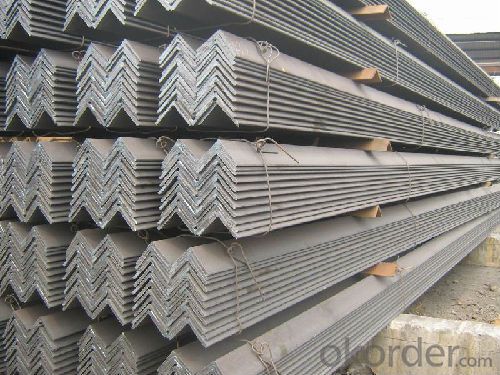
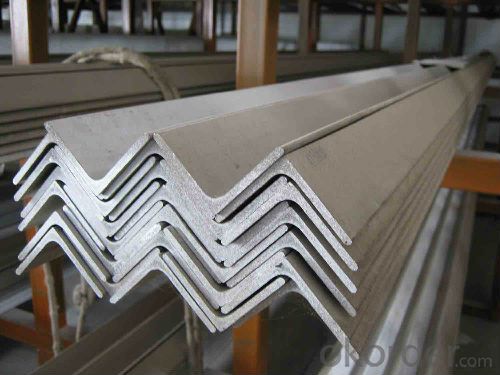
- Q: How do steel billets contribute to the manufacturing of machinery and equipment?
- The role of steel billets in the manufacturing of machinery and equipment is crucial. These semi-finished steel products serve as raw materials in various manufacturing processes. A primary contribution of steel billets to machinery and equipment manufacturing lies in the production of steel bars and rods. These shapes, essential components in the construction of machinery and equipment, are created by heating and then rolling or forging steel billets. Steel bars and rods provide strength, durability, and stability to machine structures. Additionally, steel billets are utilized in the production of other steel components such as gears, crankshafts, and axles. These components are vital for the proper functioning of machinery and equipment, requiring the high strength and toughness offered by steel billets. Manufacturers can rely on steel billets to ensure their machinery and equipment can withstand heavy loads, vibrations, and other demanding conditions. Furthermore, steel billets are commonly employed in the production of steel pipes and tubes, which find widespread use across various industries. These pipes and tubes are essential for transporting fluids, gases, and other materials within machinery and equipment. By utilizing steel billets, manufacturers can create pipes and tubes that not only possess strength and durability but also resist corrosion and wear. Moreover, steel billets contribute to machinery and equipment manufacturing by enabling the production of precision-engineered components. Manufacturers can machine, drill, and shape these billets to meet the specific requirements of different machinery and equipment. This flexibility allows manufacturers to produce intricate and complex components necessary for the efficient operation of machines. Overall, steel billets are integral to the machinery and equipment manufacturing process. They provide the necessary strength, durability, and versatility required to produce components capable of withstanding the demanding conditions of industrial applications. Without steel billets, the manufacturing industry would face difficulties in producing reliable, efficient, and long-lasting machinery and equipment.
- Q: What are the different forging methods used for steel billets?
- There are several different forging methods commonly used for steel billets, including open die forging, closed die forging, and upset forging. Open die forging involves shaping the steel billet between flat or shaped dies, allowing for greater flexibility in forming complex shapes. Closed die forging, on the other hand, involves placing the billet between two dies that have a pre-determined shape, resulting in a more precise final product. Upset forging is a method used to increase the diameter or thickness of the billet by compressing it axially, often used to create shorter and thicker components.
- Q: How are steel billets used in the manufacturing of slabs?
- Steel billets are used in the manufacturing of slabs by being heated and then rolled into a flat shape. The billets act as the starting material for the slab production process, undergoing various treatments and forming operations to achieve the desired dimensions and properties of the final slab.
- Q: How are steel billets used in the production of agricultural components?
- Various agricultural components rely on steel billets as an essential raw material. These billets act as the foundation for the manufacturing process and are transformed into a diverse range of agricultural components, including plows, harrows, tillers, cultivators, and seeders. Initially, the steel billets are melted and cast into a solid form, usually rectangular or square, with a consistent cross-section. This solid steel piece is then heated and rolled into the desired shape and size required for the specific agricultural component being produced. After rolling and shaping the billets, they undergo further processes such as cutting, drilling, bending, and welding to create the final agricultural component. These components are specifically designed to endure the demanding conditions of the agricultural industry, including exposure to harsh weather, heavy loads, and frequent use. Steel billets offer several advantages in the production of agricultural components. Firstly, steel is a sturdy and resilient material that provides the necessary strength and durability for effective agricultural machinery operation. Additionally, steel is highly resistant to corrosion, ensuring that the agricultural components can withstand exposure to moisture, fertilizers, and other commonly used farming chemicals. Moreover, steel billets can be easily customized and fabricated into various shapes and sizes, allowing for the production of a wide variety of agricultural components tailored to specific farming needs. The versatility of steel billets also enables manufacturers to create components with intricate designs and features, enhancing their functionality and performance. In conclusion, steel billets play a crucial role in the production of agricultural components. The versatility, strength, and durability of steel make it an ideal material for manufacturing machinery and equipment used in the agricultural industry. By starting with steel billets and transforming them through various manufacturing processes, agricultural components are created that can withstand the demanding conditions of farming, contributing to the efficiency and productivity of agricultural operations.
- Q: What are the main factors affecting the quality of steel billets?
- There are several main factors that can significantly affect the quality of steel billets. These factors include the composition of the steel, the temperature and time of the heating process, the cooling rate, and the presence of impurities. Firstly, the composition of the steel plays a crucial role in determining its quality. The presence of certain elements such as carbon, manganese, and silicon can affect the mechanical properties of the steel, including its strength and hardness. The proper control and balance of these alloying elements are essential to ensure the desired quality of the steel billets. Secondly, the temperature and time of the heating process during the production of steel billets are critical factors. The heating process must be carefully controlled to achieve the optimal temperature for the desired transformation of the microstructure. Overheating or underheating can lead to the formation of undesirable phases or an inconsistent microstructure, which can negatively impact the quality of the billets. The cooling rate is another important factor affecting the quality of steel billets. The cooling process needs to be controlled to achieve the desired microstructure and mechanical properties. Too rapid cooling can result in the formation of brittle phases or residual stresses, while slow cooling can lead to coarse-grained structures with reduced strength. Furthermore, the presence of impurities in the steel can significantly affect its quality. Impurities such as sulfur, phosphorus, and non-metallic inclusions can decrease the mechanical properties and promote the formation of defects in the steel billets. Therefore, strict control of the raw materials and the implementation of effective refining techniques are necessary to minimize the presence of impurities. In conclusion, the main factors affecting the quality of steel billets are the composition of the steel, the temperature and time of the heating process, the cooling rate, and the presence of impurities. By carefully controlling and optimizing these factors, steel manufacturers can produce high-quality billets that meet the desired specifications and performance requirements.
- Q: How are steel billets inspected for chemical composition?
- Steel billets are typically inspected for chemical composition through a process called spectroscopy. In this method, a small sample is taken from the billet and analyzed using specialized instruments such as optical emission spectroscopy or X-ray fluorescence spectroscopy. These instruments measure the emission or absorption of specific wavelengths of light to determine the concentration of different elements present in the steel. This allows for accurate assessment of the chemical composition of the billet, ensuring it meets the required specifications.
- Q: What are the different sizes of steel billets?
- The sizes of steel billets can vary depending on the specific requirements and industry standards. However, common sizes range from small billets measuring around 100mm by 100mm to larger ones measuring several meters in length and width.
- Q: Who knows the diamond is?Who knows the diamond is carbon? Is it C60?
- It is also called the diamond diamond, crystal, it is not the molecules themselves, so the formula does not apply to.C said it is only by this kind of carbon elements. While C60 is footballene is another matter, the 60 is because it is a molecular crystal, each molecule consists of 60 carbon.
- Q: What are the common heat treatment processes for steel billets?
- There are several common heat treatment processes for steel billets. These processes are used to alter the mechanical properties of the steel, such as its hardness, strength, and toughness, to meet specific requirements for different applications. One of the most common heat treatment processes for steel billets is annealing. This involves heating the steel to a specific temperature and holding it at that temperature for a certain period of time, followed by slow cooling. Annealing helps to relieve internal stresses in the steel, improve its machinability, and enhance its ductility. Another commonly used heat treatment process for steel billets is quenching and tempering. Quenching involves rapidly cooling the steel from a high temperature to room temperature using a liquid or gas medium, such as water or oil. This process results in a hardened steel with increased strength and hardness. However, the steel becomes brittle after quenching, so it is then tempered by reheating it to a lower temperature and holding it at that temperature for a specific duration. Tempering reduces the brittleness and improves the toughness and ductility of the steel. Normalizing is another heat treatment process used for steel billets. It involves heating the steel to a temperature above its critical transformation temperature and then cooling it in still air. Normalizing helps to refine the grain structure of the steel, improve its mechanical properties, and enhance its machinability. Lastly, there is also the process of stress relieving, which is used to reduce internal stresses in the steel billets that may have been generated during manufacturing processes such as casting or forging. Stress relieving involves heating the steel to a specific temperature and holding it at that temperature for a certain period of time, followed by slow cooling. This process helps to improve the dimensional stability and reduce the risk of distortion or cracking in the steel. Overall, these common heat treatment processes for steel billets play a crucial role in optimizing the properties and performance of the steel for various industrial applications, ranging from automotive and construction to aerospace and energy sectors.
- Q: What are the potential applications of steel billets in the telecommunications industry?
- Steel billets can be used in the telecommunications industry for various applications such as tower construction, antenna support systems, and cable management. The strength and durability of steel make it an ideal material for these purposes, ensuring the stability and longevity of telecommunications structures. Additionally, steel billets can be used for manufacturing equipment and components like brackets, frames, and enclosures, providing protection and support for sensitive telecommunications devices.
Send your message to us
Steel Equal Angle 20MM-250MM GB Q235 20-250MM
- Loading Port:
- Tianjin
- Payment Terms:
- TT or LC
- Min Order Qty:
- 25 m.t.
- Supply Capability:
- 200000 m.t./month
OKorder Service Pledge
OKorder Financial Service
Similar products
Hot products
Hot Searches
Related keywords

